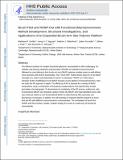| dc.contributor.author | Golder, Matthew R | |
| dc.contributor.author | Nguyen, Hung VanThanh. | |
| dc.contributor.author | Oldenhuis, Nathan | |
| dc.contributor.author | Grundler, Julian | |
| dc.contributor.author | Park, Ellane J. | |
| dc.contributor.author | Johnson, Jeremiah A. | |
| dc.date.accessioned | 2020-06-02T15:01:12Z | |
| dc.date.available | 2020-06-02T15:01:12Z | |
| dc.date.issued | 2018-12 | |
| dc.identifier.issn | 0024-9297 | |
| dc.identifier.uri | https://hdl.handle.net/1721.1/125609 | |
| dc.description.abstract | The efficient synthesis of complex functional polymeric nanomaterials is often challenging. Ru-initiated ring-opening metathesis polymerization (ROMP) of multivalent macromonomers followed by cross-linking to form brush-arm star (BASP) polymers enables access to well-defined nanostructures with diverse functionality. This "brush-first" method leaves active Ru in the BASP microgel core, which could potentially be used in a subsequent "ROMP-out" (RO) step to introduce further modifications to the BASP structure via the addition of (macro)monomers. Here, we study this RO approach in depth. The efficiency of RO is assessed for a variety of BASP compositions using a combination of inductively coupled plasma mass spectrometry and gel permeation chromatography. To demonstrate the modularity of the RO process, arylboronic acid-functionalized BASPs were prepared; uptake of these RO-BASPs into hypersialylated cancer cells was enhanced relative to non-functionalized BASPs as determined by flow cytometry and fluorescence microscopy. In addition, the self-assembly of miktoarm BASPs prepared via brush-first and RO with different macromonomers is demonstrated. The combination of brush-first ROMP with RO provides a simple, modular strategy for access to a wide array of functional nanomaterials. | en_US |
| dc.description.sponsorship | National Institutes of Health (U.S.) (Grant (1R01CA220468–01) | en_US |
| dc.description.sponsorship | Rollins College (Winter Park, Fla.). Dean of the Faculty Office. Critchfield Research Grant (110000–46333) | en_US |
| dc.description.sponsorship | National Institutes of Health (U.S.). Post-doctoral Fellowship (1F32EB0231–01) | en_US |
| dc.description.sponsorship | National Institutes of Health (U.S.). Post-doctoral Fellowship (1F32GM123710–01) | en_US |
| dc.description.sponsorship | National Cancer Institute (U.S.) (Grant P30-CA14051) | en_US |
| dc.description.sponsorship | United States. Department of Energy. Office of Science (Contract DE-AC0206CH11357) | en_US |
| dc.language.iso | en | |
| dc.publisher | American Chemical Society (ACS) | en_US |
| dc.relation.isversionof | https://dx.doi.org/10.1021/ACS.MACROMOL.8B01966 | en_US |
| dc.rights | Article is made available in accordance with the publisher's policy and may be subject to US copyright law. Please refer to the publisher's site for terms of use. | en_US |
| dc.source | PMC | en_US |
| dc.title | Brush-First and ROMP-Out with Functional (Macro)monomers: Method Development, Structural Investigations, and Applications of an Expanded Brush-Arm Star Polymer Platform | en_US |
| dc.type | Article | en_US |
| dc.identifier.citation | Golder, Matthew R. et al. “Brush-First and ROMP-Out with Functional (Macro)monomers: Method Development, Structural Investigations, and Applications of an Expanded Brush-Arm Star Polymer Platform.” Macromolecules 51 (2018): 9861-9870 © 2018 The Author(s) | en_US |
| dc.contributor.department | Massachusetts Institute of Technology. Department of Chemistry | en_US |
| dc.relation.journal | Macromolecules | en_US |
| dc.eprint.version | Author's final manuscript | en_US |
| dc.type.uri | http://purl.org/eprint/type/JournalArticle | en_US |
| eprint.status | http://purl.org/eprint/status/PeerReviewed | en_US |
| dc.date.updated | 2019-12-20T16:31:32Z | |
| dspace.date.submission | 2019-12-20T16:31:42Z | |
| mit.journal.volume | 51 | en_US |
| mit.journal.issue | 23 | en_US |
| mit.metadata.status | Complete | |
